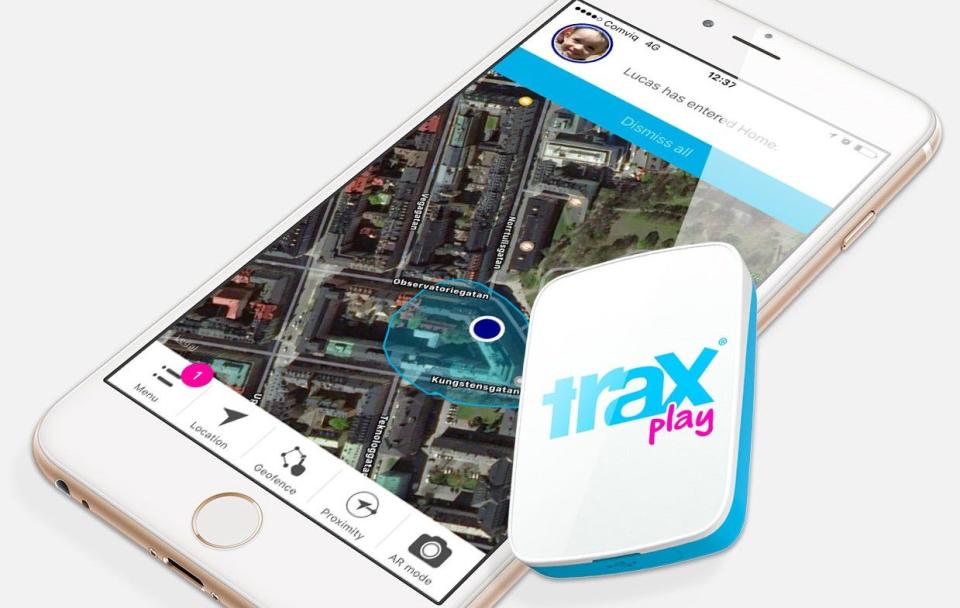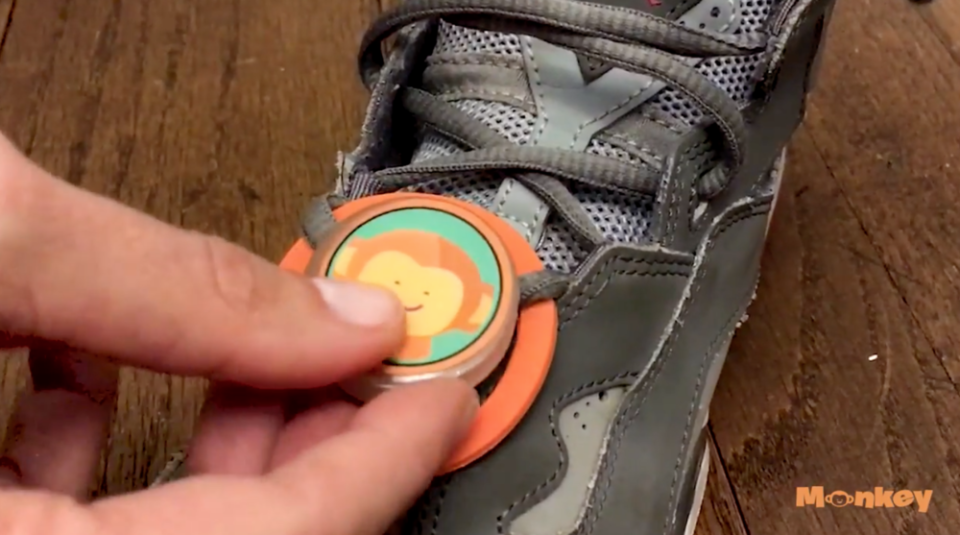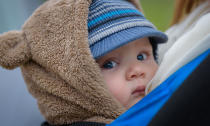How child-security apps lengthen the reach of parents
Thanks to technology, there's a middle ground between helicopter parenting and hands-off parenting.
My son recently turned 3 years old. Now that he's a "big boy," he wants to explore and run ahead of me, even though he lacks the wherewithal and caution to do so. My instincts, as a first-time father, are to hold onto him for dear life.
I can't hold onto my son forever. But there are steps I can take to lengthen my reach before I let go entirely. Via GPS and beacon technology, developers are creating child trackers -- security apps and hardware to address the modern parent's primary preoccupying concern: "Where is my child right now?"
The increased prevalence of child trackers lends itself to sensationalist media coverage; the most dramatic measures, such as implanting a microchip under a child's skin, get a disproportionate amount of press. In an article for The Guardian in 2016, technology journalist Nicole Kobie interviewed child rights advocates, who cautioned against the use of child trackers.
"Ultimately, trusting children to make the right decisions and giving them the freedom to do so is a big part of growing up," Kobie said. "This should not be lost sight of by parents, who may turn to tracking technology as a crutch to get over the difficulty of letting go."
"Parents need to teach their children to be independent and to be able to cope with risks and dangers," said Open Rights Group Communications Director Pam Cowburn.
No tracker can replace strong parenting and consistent watchfulness. But in a technology-driven world, which moves faster each year and demands immediacy from its professionals, tracking technology can enhance modern parenting. Its usage need not be a surrender of responsibility.

In 2013, Swedish company Wonder Technology Solutions AB developed Trax, which uses GPS to track children when they travel outside the home. The tracker clips to a child's pocket or waistband, and the corresponding app, which is available on iOS and Android, syncs with the tracker.
"The idea is to deliver peace of mind," said Michel Bracké, CEO for WTS AB. "If something happens, you'll have a tool that allows you to react to it as quickly as possible."
Trax Play enables parents to trace a "geofence" around a location, such as a school building. The app notifies parents when the child has reached the fenced location and will notify parents if the child steps outside its bounds. Trax can also create a proximity fence around the app user and send a notification if the child steps outside a pre-assigned radius. It can set speed alerts, which gauge how quickly the child is moving, enabling parents to discern whether their child is traveling on foot or by car.
Trax is marketed to individual consumers, but also to schools. WTS recently partnered with fellow Swedish company Ample AB. Its product, PrestoDaycare, is a digital toolkit that integrates technology into traditional schools. This allows teachers to manage the classroom (creating digital student portfolios, taking attendance, scheduling 1-on-1 conferences) and communicate with the parents (updating the online calendar, tracking student progress, and issuing grade reports).
Ample is testing Trax in three nurseries across Sweden. It hopes to finish these trials by fall 2018 before determining prices with WTS and beginning its marketing. Ideally, the final product will integrate Trax into the pre-existing PrestoDaycare toolbox. All the teacher would need is a tablet or a smartphone to manage everything.
"The teachers' feedback told us that this is very good for excursions," said Richard Jones, CEO of Ample. "Kids are fast. And the teachers are much more secure in the work life. They can do things with the kids like take them out to museums or the woods without feeling there are too few of them to handle the kids.
"[These child trackers] are the new way to do business," Jones continued. "And the parents will ask for it eventually. We regularly get questions from schools who want to incorporate this."
Trax is popular with consumers in the US, Canada and Europe and will arrive this year in Australia and Singapore. Bracké sees a trend of globalization at work -- that as people travel more to unfamiliar environments, they'll take comfort in technologies that can provide extra security. But depending on a family's budget, the cost ($99, plus a monthly subscription starting at $4) might be prohibitive. Other GPS trackers can cost north of $150. There are cheaper, more specialized options available.

For five minutes, Kim Gavin lived every parent's worst nightmare. Three years ago, she and her husband took their two daughters to a playground party place -- a mish-mash of different inflatable play areas and bounce houses in a single, massive room. No adults were allowed inside the children's area, but Gavin was assured that the area was enclosed. So she kept a loose eye on her kids from a distance.
But then Gavin didn't see her youngest daughter, who was 3 years old at the time. She informed her husband, who didn't see her either. The panic started to set in.
"At first, you worry, 'Is she trapped underneath something?" Gavin said. "And then you worry, 'Did somebody take her?' It was my first real experience losing a child, and it was horrifying."
As it turned out, the play area wasn't as enclosed as everyone had thought. Her daughter had squeezed her way out and into the building's lobby, where an employee pulled her aside and kept her safe. But those five minutes of helplessness inspired Gavin to take action; were this to happen again, she wanted to be more proactive.
Gavin is a technical consultant for a medical-device company, so she sought out a technological solution. She took inspiration from the Tile tracker, which uses Bluetooth beacon technology to locate people's wallets and keys. By December 2016, Gavin had a working prototype for Monkey, a product that relies on beacon technology instead of GPS to keep children safe. It debuted at CES in January.
Parents can use the Monkey app to set a range for the child -- most opt for the 15-to-30-foot range. The smartphone then serves as a beacon: As the child moves farther away and the signal gets weaker, the status of the "monkey" will turn from green to yellow to red. The app will set off an alarm to alert the parent that the child has moved out of range.
"Typically, beacon technology is lower cost than GPS," said Steven Statler, who hosts a beacon-technology podcast and is the senior VP of marketing and business development at Wiliot. "You can also make it really small, even the size of a guitar pick."
The Monkey tracker is a preconfigured RadBeacon Dot; its radio board is incorporated into a kid-friendly exterior and attached to the child's shoe. The form factor was something Gavin worked on for more than six months. It needed to be something appealing to boys and girls, and tolerable to wear. Gavin considered a lanyard and even a clunky bracelet before settling on the current design.
"Monkey is for that critical 1-2 minute range of when kids start to go wandering," Gavin said. "The average child wanders approximately 300 yards from their parents, so I wanted something that would work closely and in real time. The beacon was perfect for that."
Because beacon technology is a local connection between the beacon and its recipient, it uses considerably less power than GPS, which triangulates signals from satellites in space to get its bearings. And because most parents will use this technology on the go, they will need to consistently charge their phones for GPS to be constant and effective.
"One of the horror stories [among developers] is that you put all this effort into having people download your app and install it," Statler said, "and then, once they find that the power on their phones is being run down, they'll uninstall it.
"Unlike GPS, beacons also work when indoors," Statler continued. "If you're in an environment like a classroom or a shopping mall, you're out of luck."
One needs a clear view of the sky for GPS to be accurate and effective. Otherwise, there could be up to a three-to-four-minute delay -- precious time in the event of an abduction. Bracké concedes this point, noting that GPS trackers will log the last known outside location -- usually the entrance to a building -- so a parent will know where a child went. It would then continue tracking the child if he or she were to head back outside. Bracké points that beacon tracker apps also have limits.
"They are alerts, in principle," said Bracké. "They can tell you that you have lost something. But if you want to know where, you can't, because it's already gone."
Trax plans to integrate Bluetooth technology into future models -- that way, the devices can have the best of both beacon and GPS technology: precise location at a close distance and real-time tracking from afar. Its upcoming Trax LTE Cat M1 model, due out by late 2018, will include this plus wireless charging.
Monkey, meanwhile, is a budget option that executes one strategy -- proximity tracking -- very well. It is available on iOS and will available on Android by the end of May. For future models, Gavin wants the tracker to have a real-time "distress signal" where the beacon vibrates and notifies the child when he or she has stepped out of bounds. She also wants to leverage the new Bluetooth 5.0 technology to expand how far the tracking will reach. Gavin anticipates launching the second-generation Monkey device in late summer.

And what of those who feel these child-tracker apps feed into parental complacency? The knee-jerk response might be to dismiss this entirely -- to blame parents for not keeping track of their children, rather than seeking solutions from tech startups. But now that I'm a father and I worry all the time, I have more empathy. Even for parents who don't check their phones, it's easy enough to lose track of a child in a crowd -- the line of sight need be broken only once.
Factor in a child's natural curiosity and impulsiveness, you have a recipe for danger. If the child is autistic or has ADD, that can complicate matters further, even for professionals. In 2013, an autistic, nonverbal student named Avonte Oquendo ran away from his New York City school; his body later washed up on the shores of the East River. The school had multiple security guards and licensed caregivers, but Avonte still left the grounds without being followed, and there were no alarms on the doors. These were later added to New York public schools in compliance with Avonte's Law.
Child trackers can be a tertiary option for when all else fails. It's not about alarmist fears of the boogeyman in the bushes -- it's about losing a child near a street intersection, or the ocean or a subway platform -- a mundane yet hazardous environment that a wandering child would struggle to navigate.
For working parents, technology has altered the work/life balance. The new normal, of being constantly connected and on call, disperses one's attention.
"Compare the multitasking now versus the multitasking 10 years ago," said Gavin. "It's unfair to criticize parents for using a mobile application to keep their children closer to them.
"I'm not saying it's good, but it's the reality of what we're living in," Gavin continued. "Our expectation of each other is higher -- to answer email quicker and answer the phone quicker simply because we're carrying a mobile phone. In corporate America, we need to answer email in three minutes or we're deemed 'unresponsive.'"
Children don't choose to wander when it's most convenient for the parent to chase them. And child trackers can supplement a parent's vigilance in a world where people's attention spans are fragmented and shortened. The realistic solutions to technology's drawbacks may come, ironically, from technology.
Presently, it is difficult to ascertain the effectiveness of these apps. After all, if the app works the way it's supposed to, dangerous situations are preemptively defused.
"The stories you read in the news are the ones where things have gone wrong," Bracké noted.
Bracké recalls a recent story from February 2018, when two brothers got lost while on a skiing trip in the French Alps. They fell off a cliff, and by the time the boys were found, the elder one had died of his injuries. Sadly, there are multiple accidents, exactly like this one, every year. Was this preventable with the benefit of hindsight? How many potential tragedies never materialize thanks to tracker technology? If that's true, how does one measure the absence of data as a positive indicator?
It reminds me of my own responsibilities as a high school teacher. For several years, I trained a number of my students in conflict mediation, who would then intercede into student-to-student and student-to-teacher conflicts. Often, my students would preempt conflicts before they spiraled out of control. A petty squabble over seats at the lunch table, for example, needed to be addressed before resentment built and escalated into something worse. As a result, there were very few conflicts which required an "official" mediation, with a pre-interview, an organized sit down, and a post-reflection.
Preemptiveness is largely thankless; the recognition goes to those who interrupt catastrophes in progress. The motivation to persist comes not from an external, positive reinforcement. Rather, it's the inward confidence of knowing there was a benefit -- even if one cannot see it or measure it. So it goes with child security trackers, and by extension, parenting. Nothing is certain. It comes down to a matter of faith that you're doing enough, and you're prepared for an emergency should it come to pass.










